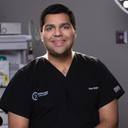Posted underPRP for Hair Loss q&a
PRP right option for my hair loss? Thinning of hair in front. 26 years, male (Photo)
I am 26 years Male suffering from Hair loss. I checked with a leading dermatologist in Chennai and was advised I am not good for transplant. She suggested PRP will work for me. Any side effects on PRP? Please let us know with your Reviews and answers. Please find my attached pictures of scalp where have I applied oil. Please suggest the best treatment for me to restore/regrow hair. I don't want to try Minoxidil or Propecia as they have severe side effects. please help. Is it Tellogen effluvium?
Answers (35)
From board-certified doctors and trusted medical professionals

Dr. Cameron Chesnut, MD, FAAD, FACMS
Dermatologic Surgeon, Board Certified in Dermatology
Answer

Dr. Catherine Weng, MD
Facial Plastic Surgeon, Board Certified in Otolaryngology – Head and Neck Surgery
Answer

Dr. Jae Pak, MD
Hair Restoration Surgeon, Board Certified in Emergency Medicine
Answer
More PRP for Hair Loss Questions
See all PRP for Hair Loss Q&AWE SEND PRETTY
EMAILS
What’s trending? Who’s turning heads? Which TikTok myths need busting? We’ve got you. No fluff, no gatekeeping—just real talk. Get our free, unfiltered newsletter.






